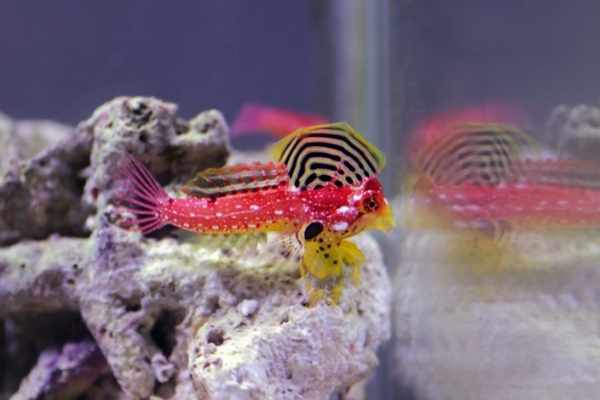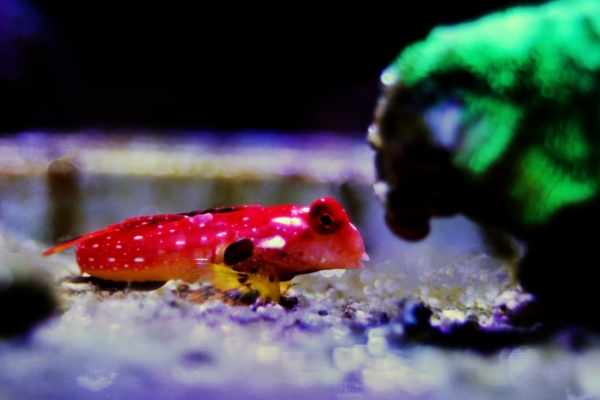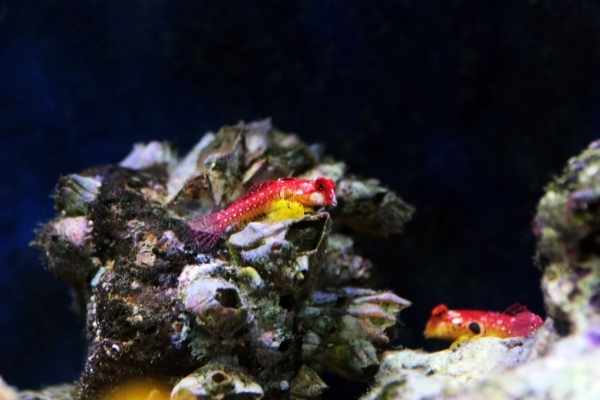The ruby red dragonet (Synchiropus sycorax) holds a special place in aquarium history. This gorgeous member of the Callionymidae family made an appearance in the aquarium industry THIS century. Not impressive enough? What if I also mentioned they did so without a scientific name? STILL not impressed? How about if I told you their eventual name came from a pop culture icon? Whatever the reason, these vibrant little dragonets are popular with hobbyists. Well, those with the experience to handle them, anyway.
Table of Contents: Ruby Red Dragonet Care
Tracking down a ruby red dragonet isn’t a difficult task. After all, they started showing up in fish stores before anyone knew what they were. (It isn’t often a trade name hits publication ahead of scientific classification) Where the tricky part comes in is with managing and keeping these personable little fish thriving. Good thing you’re here! You’ll find everything you need in the links below.
- Quick Facts
- Description of the Ruby Red Dragonet
- Ruby Red Dragonet Lifespan
- Creating the Ideal Ruby Red World
- Ruby Red Dragonet Diet
- Ruby Red Dragonet Behavior and Tank Mates
- Breeding the Ruby Red Dragonet
- Pros and Cons
- For More Information

Quick Facts
- Common Names: Ruby red dragonet, Ruby dragonet, Moyer’s dragonet, Red wine scooter dragonet
- Scientific Names: Synchiropus sycorax
- Size: 3 inches (7.6cm)
- Minimum Tank Size: 30 Gallons (114L) for ONE; 55 Gallons (208L) for a pair
- Reef Safe? Yes
- Care or Experience Level: Expert
- Preferred Diet: Carnivore
- Original Part of the World: Philippines
Description of the Ruby Red Dragonet
It isn’t THAT difficult to see where the ruby red dragonet got that fancy trade name. The saturated scarlet hue stands out against the best reef structures. (Yes, even small as the fish may be) The white patterns around the head and yellow streaks along the ventral and pectoral fins serve to highlight the bright red color. And the black outlines are the perfect extra touch. It’s no wonder hobbyists scrambled to pick them up – scientific classification or not. (After all, who needs to know the Latin name of a fish to enjoy it?)
The little dragonets hit the aquarium trade at the beginning of 2013 – a recent addition to the hobby. And scientists didn’t catch up with a name until 2016. That’s when they finalized their formal descriptions, assigning a designation of Synchiropus sycorax. And if you’re a fan of Dr. Who, that probably sounds familiar. You guessed it: the fish earned their name from the Sycorax warriors from the popular sci-fi series. (If you’re NOT a fan, Sycorax wear over-the-top red and yellow uniforms, Also, WHY are you not a fan?)

Why’d it take three years to pin down the classification? Well, ruby red dragonets (officially known as ruby dragonets, by the way; saying “ruby red” is a little like saying “ice cold”) look similar to redback dragonets (Synchiropus tudorjonesi). They have the same red and white color palette. But then things branch. Redbacks don’t have any yellow on their fins. And when you take a look at the dorsal fins, ruby reds have a long first spine. In redbacks, it’s the third spine that extends the highest.
But when examining fish this small in NARROW geographic regions, it takes time to jot down the differences.
Ruby red dragonets behave the same as others in the family, though. The wide ventral fins allow them to perch on surfaces and “walk” along the substrate. When they DO need to swim, they look reasonably clumsy at the task.
Ruby Red Dragonet Lifespan
You’ll only find ruby red dragonets in the Philippines. They’re native to areas of coral and broken rock throughout the islands. This, of course, also sets them apart from their redback cousins. Redback dragonets stay around Cenderawasih Bay in Indonesia. (However, when you’re buying a fish from a fish store, you don’t always know where it came from)
With proper care, a ruby red dragonet can survive for around 4-6 years. That IS the kicker, though. They’re challenging to manage. Most hobbyists decide to admire the species from afar. (It saves on the aggravation)

Creating the Ideal Ruby Red World
Even with that scarlet color, you may need to hunt to find a ruby red dragonet when you’re diving in the Philippines. They’re not the largest fish in that region. And they don’t show up in the shallows – popular with holiday snorkelers. The species hides in and around coral rubble at a depth of 125 feet (30m). They use the soft and stony corals as retreats.
To kick off your list of ruby red needs, start at the beginning. You want a mature tank AT LEAST 6-8 months in age. Yes, this ensures everything’s cycled, but it’s more than that. This dragonet has a specialized diet. (Okay, so most dragonets do) You need that much time to allow the menu to proliferate throughout the tank. Without a ready food supply, your little red and yellow fish won’t make it. Start on the right foot (fin?) and give your aquarium time to mature.
Then choose the right bottom. A layer of live sand will provide the “ground” material a ruby red dragonet needs for its food source. And it’s ideal for them to walk and hop around. You should also add plenty of live rock structures throughout the tank. Again, you’re providing the source for some of your dragonet’s meals. The rock also gives them places to hide in and explore. Combine the two, and you’ll have a START on that menu.
Ruby Red Dragonet Tank Size
Even full-grown, ruby red dragonets don’t get very large; not more than 3 inches (7.6cm). If you look at the minimum space requirements, that suggests you can get away with a 30-gallon (114L) tank without a problem. And you can – if you only plan to keep ONE dragonet, with no other fish. The issue isn’t the size of the fish but ensuring you provide enough real estate for grazing and food production. Fail that requirement, and your little Sycorax warrior isn’t long for the world.
A better minimum tank size – at least for a pair – is 55 gallons (208L). You’ll have better control over the tank’s water parameters and health. And you can aquascape the aquarium to maximize the growth of algae and pods. But if you want to go for the gold, set up a 75-gallon (284L) tank. You’ll have room for more than one ruby red dragonet (with appropriate décor), and you shouldn’t have to struggle to keep the fish fed.
Whichever size tank you choose, ensure you have a tight-fitting cover. ALL of the members of the dragonet family have superb jumping skills. And since ruby reds fall on the small side of things, they can wriggle through tight spaces. You don’t want to walk in and find your VERY difficult to care for fish carpet surfing.

Are Ruby Red Dragonets Reef-Safe?
Ruby red dragonets have a specialized diet. It’s one of the most challenging aspects of their care. Luckily, though, that menu DOESN’T include corals. You can happily set them up in a reef tank. Of course, that’s assuming you’re capable of providing enough food for the fish AND the invertebrates. (If you target-feed your corals, this isn’t an issue)
You do want to be careful about combining ruby reds with sea anemones, though. The fish are small and a little too trusting. It’s not uncommon to wake up and find out your ruby red dragonet ended up as an anemone snack overnight.
Ruby Red Dragonet Diet
Any hobbyist considering adding a ruby red dragonet to their aquarium needs A LOT of preparation on the diet end. This is, without a doubt, the most troubling part of the management. With FEW exceptions (think of the smallest percentage you can), the species WON’T convert to a commercial diet. And if you fail to provide their preferred menu, they WILL starve.
Ruby red dragonets – like most of their cousins – are carnivores. And they want a specific subset of the meaty menu. They’re not the fastest fish in the world, nor are they imposing in terms of size. So that means they prefer pods: amphipods and copepods, to be specific. And plenty of them! Without a CONSTANT supply of pods, a ruby red will slowly starve to death.
Your best bet is to build your tank with live sand, live rock, AND a well-stocked refugium. This will ensure your dragonet can forage to its heart’s content. And you’ll win in the process as you get to watch them hop around the structures, snapping up the tiny morsels.
That doesn’t mean you can’t offer other protein options. As long as you go the live route, anyway:
- Bloodworms
- Brine shrimp
- Glassworms
- Mysis shrimp
You should also consider a supply of marine algae and nori. Supplementing the greens won’t hurt. Just don’t expect your ruby red dragonet to turn vegetarian on you. They want those pods to comprise 99% of the menu. And they WILL waste away in protest if you don’t comply. You can try adding frozen proteins into the mix but be prepared for rejection. It’s not worth trying to out-stubborn that little red fish.
Ruby Red Dragonet Behavior and Tank Mates
Ruby red dragonets spend most of their day chasing down food. (When you eat something as tiny as copepods, it takes a long time to fill up!) It makes them engaging to watch and an active part of any saltwater aquarium. They’re not the fastest fish in the world, though. Those prominent fins make them a bit clumsy. And they don’t present much competition to their tank mates.
As such, it’s NEVER a good idea to put dragonets in a tank with other pod-feeders. Unless you’re 100% confident you can provide enough food for everyone, the odds are not in your favor. Someone will end up starving. Choose one species. If you love the look of the ruby red dragonet, stick with it. Otherwise, they’ll probably end up losing to another fish.
The good news is you CAN keep more than one ruby red in a tank. They have a peaceful temperament and get along with one another. At least, they WILL if you introduce them at the same time. You should ideally choose a ratio of one male to 2-3 females. This will prevent fighting between males (particularly during spawning).

However, the little Sycorax warriors get territorial when around other blennies, gobies, or dartfish if they feel crowded. You’ll want to err on the side of space if you want to combine these groups. Some creative aquascaping will help break up the sightlines and prevent your favorite red and yellow fish from starting fights.
As long as you avoid any overtly aggressive tank mates, though, ruby red dragonets make ideal reef fish. You can house them with any of the following groups:
Breeding the Ruby Red Dragonet
Until 2016, breeding ruby red dragonets seemed impossible. Then ORA presented the first batch of captive-bred Sycorax warriors. As it turns out, the larvae aren’t as large or quick to develop as red scooter blennies (Synchiropus ocellatus) or brown scooter blennies (Synchiropus stellatus). It made things complicated – at first.
What ISN’T complicated is deciding whether you have a male or female. The two are about the same size, and they both possess a double dorsal fin. But male ruby red dragonets have the more colorful, prominent first dorsal fin. And if you get two males near each other? You’ll see them use those fins to engage in a dominance battle.
This can get a little confusing during spawning. See, males and females ALSO flip up those fins – but as part of a courting ritual. Take a look at the YouTube video below for an example:
See the difference in those dorsal fins? You’re seeing male and female pairs, not males demonstrating aggression. (If you don’t know how to tell the sexes apart, though, you may get confused) That courtship starts the spawning process. It’s followed by a swim toward the surface with locked fins. This usually happens in the evening when the sun goes down (or you turn off the lights). At the top of the arch, the pair releases their gametes.
Ruby red dragonets don’t have a high fertility rate. It’s one of the other complications to breeding them. And then there’s that slow development. It takes 20-25 days for the larvae to metamorphose. A bit much for the average hobbyist. (Especially when you factor in the care of those demanding larvae) Good thing ORA’s on the case, offering captive-bred lines.
Pros and Cons
Ruby red dragonets aren’t the oldest species in the trade. However, they still top the charts in popularity. And despite the fact their range is relatively confined, they’re not delicate. It’s one point in their favor. You still want to add up all of the other points before you bring one home for your tank, though.
Pros
- Ruby red dragonets remain active throughout the day as they hunt for pods, “walking” on their ventral fins.
- Courtesy of ORA, you can now purchase captive-bred ruby reds, lessening the environmental impact on the species.
- Ruby red dragonets have a peaceful temperament, even getting along well in groups – provided you introduce all of the fish simultaneously.
Cons
- Ruby red dragonets have a specialized diet, requiring live pods in hefty numbers to prevent wasting away.
- You need a mature tank of at least 6-8 months with live sand and live rock before introducing a ruby red.
- Ruby red dragonets don’t tolerate sharing small aquariums with other blennies, gobies, or dartfish.
For More Information
New aquarium species in the trade don’t happen THAT often. (New varieties, sure. New species? Not so much) And a trade name showing up before science made a classification? That’s pretty rare. This set the ruby red dragonet apart from others in the family. Not to mention all of the other notable “extras.” It’s made them tops on the popularity chart. And while that SHOULD be enough, you may need a tiny bit more convincing (or, you know, simply want some additional information).
This YouTube video walks you through everything you need to know about ruby red dragonets:
Want to know about some of the best ruby red dragonet tank mates?
Feel you can handle a challenging species? Then look at these other pod-eaters:
Conclusions
How many other fish out there got their name from Dr. Who? (Or pop culture, for that matter) Ruby red dragonets are kind of special. And, yes, their care needs are unique. If you’re willing to manage the menu, though, they’re worth it. The colors, the activity, and the prestige of a mini Sycorax warrior? How could you say no?
References
- Adams, J. 2016. “Ruby Red Dragonet Successfully Captive Bred by ORA.” ReefBuilders.
- Pedersen, M. 2016. “New Species: Ruby Red Dragonet Formally Described.” Reef to Rainforest Media.
- Tea, Ti-Kai, and Gill, A.C. 2016. “Synchiropus sycorax, a new species of dragonet from the Philippines (Teleostei: Callionymidae).” Zootaxa. 4173 (1). 085-093.


Leave a Reply